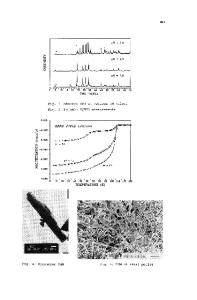Preparation of Mesoporous Oxides for Mems Structures
- PDF / 2,711,211 Bytes
- 6 Pages / 612 x 792 pts (letter) Page_size
- 81 Downloads / 392 Views
PREPARATION OF MESOPOROUS OXIDES FOR MEMS STRUCTURES Jong-Ah Paik 1, Nobuaki Kitazawa 1, Shih-Kang Fan 2, Chang-Jin Kim 2, Ming C. Wu 3, and Bruce Dunn 1 Dept. of Materials Science and Engineering 1; Dept.of Mechanical and Aerospace Engineering 2; Dept. of Electrical Engineering 3, University of California at Los Angeles , CA, USA ABSTRACT The high porosity and uniform pore size provided by mesoporous oxide films offer interesting opportunities for MEMS devices that require low density and low thermal conductivity. This paper describes recent efforts at adapting mesoporous films for MEMS fabrication. Mesoporous SiO2 and Al2O3 films were prepared using block copolymers as the structure-directing agents, leading to films which were 70% porous and < 5 nm surface roughness. A number of etchants were investigated and good etch selectivity was observed with both dry and wet systems. Micromachining methods were used to fabricate cantilevers, micro bridges and membranes. INTRODUCTION There has been an active effort in the materials chemistry community in recent years to synthesize mesoporous oxides based on the use of sol-gel chemistry in combination with structure-directing agents such as surfactants, block copolymers and colloidal suspensions [1,2,3]. In work to date, particles [4,5], fibers [6] and thin films [7,8] of various oxides have been produced with varying pore sizes (2 to 30 nm) and organized structures (i.e., hexagonal, cubic, lamellar)[9]. Although the specific mechanism for mesostructure formation is the subject of much discussion, there is the general consensus that interactions between the organic and inorganic phases control the means by which mesoscopic order develops, as oxide oligomers assemble around the regularly arranged organic micelles. The mesoporous morphology is formed upon removal of the organic phase by thermal or chemical treatment. The nanostructures created by this synthesis approach have potential applications in catalysis, optoelectronics and nanotechnology [10]. Although much of the research to date has emphasized SiO2, methods have now been extended to a significant number of other metal oxides[5]. In addition, block copolymers have emerged as a convenient group of structure-directing agents for a wide range of oxides, prompting researchers to suggest that block copolymers are part of a general synthetic approach for preparing mesoporous oxides [5]. This paper reports the first successful development of MEMS structures which incorporate mesoporous oxide films. There are several areas where the high porosity and low density of mesoporous oxides can be quite useful. One application is in micromirrors; the mass of a micromirror can be reduced by at least 70% compared to conventional silicon or polysilicon mirrors, leading to an increase in the resonant frequency and shock resistance of the mirror, while preserving the optical surface area. Another interesting opportunity for mesoporous oxides is in micro thermal devices that frequently suffer from high thermal loss because of their size. T
Data Loading...








